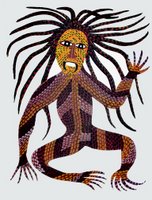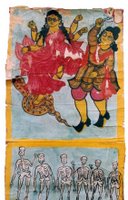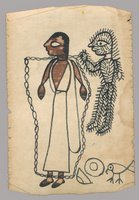The Contemporary Indian "Other Masters" Collection
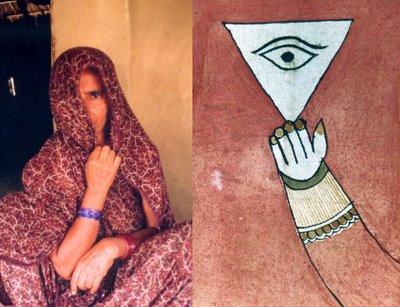 Since 1996, Hervé Perdriolle has been collecting the contemporary Indian tribal and folk art shown on this blog.
Since 1996, Hervé Perdriolle has been collecting the contemporary Indian tribal and folk art shown on this blog.
The collection includes more than 300 paintings and drawings and provides an opportunity to discover the imagery and styles of the principal tribal and folk art forms through the works of over twenty of the most renowned Indian artists. Naming the collection, “Other Masters” is intended as a tribute to the evocative title of an exhibition organised by Jyotindra Jain, when he was the Director of the Crafts Museum in New Delhi.
The Contemporary Indian "Other Masters" Collection
Depuis 1996, Hervé Perdriolle constitue une collection d’art populaire et d’art tribal contemporains indiens présentée dans ce blog.
Cette collection de plus de 300 peintures et dessins permet de découvrir les styles des principales tribus et formes d’art populaire à travers les œuvres d’une vingtaine d’artistes Indiens parmi les plus renommés. Le choix de ces oeuvres souhaite rendre un hommage au titre évocateur d'une exposition organisée par Jyotindra Jain, directeur du Crafts Museum de New Delhi, "Other Masters".

Mon premier métier avait été graphiste. Aussi, après avoir vécu trois ans en Inde, lorsque nous nous sommes réinstallés en France fin 1999, j’ai voulu suivre l’évolution des techniques concernant le graphisme assisté par ordinateur. Pour mettre en application ce que j’apprenais sur informatique, je réalisais des photomontages illustrant mon regard sur l’art en Inde, embrassant aussi bien les arts primitifs que l’art contemporain, les beaux-arts que les arts populaires.
I began as a graphic designer and after three years living in India, I returned to France in 1999 and I followed the technical evolution about the graphic design assisted by computer. To apply what I had learned, in 2000 I mounted these photomontages to express my admiration for Indian art, from the primitive to the contemporary, and from fine art to folk art. Having different kinds of art forms living together was the dream of great artist and theoretician, J. Swaminathan, who had inspired me when I started my own collection in 1996. The dialog between Souza’s drawings and the Gond mask is for me, an amazing illustration of this dream.


The Contemporary Indian "Other Masters" Collection Introduction
Introduction (english)
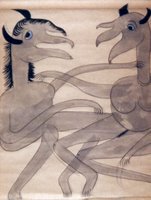
Adivasi « first inhabitants »
Whether in India or in the West, the general public is barely aware of Indian tribal art even though it is fully equal to the better known tribal art of Africa and Oceania. This ignornance derives from the powerful sacred art of Buddhism, Jaïnism, Hinduism, and Islam that has unfortunately over-shadowed the tribal arts for more than two millennia. (more)
Introduction (français)
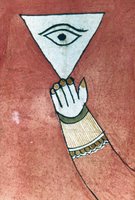
Adivasi « premiers habitants »
En Inde comme en occident, l'art tribal indien est peu connu du grand public. Pourtant, il n'a rien à envier aux autres formes d'art tribal reconnues comme celles issues d'Afrique ou d'océanie. Notre ignorance concernant l'art tribal indien tient principalement au fait qu'il fut, pendant plus de deux millénaires, occulté par le rayonnement des arts sacrés dominants issus du bouddhisme, du jaïnisme, de l'hindouisme et de la religion musulmane. (suite)
The Contemporary Indian "Other Masters" Collection
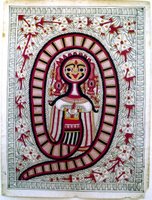
Bacchadaï Devi « Mithila painting »
Bacchadai Devi est décédée dans les années 80, aussi je ne l’ai jamais rencontré. J’avais juste vu quelques une de ses peintures reproduites dans le catalogue du seul musée au monde totalement consacré à cette forme d’art, le Mithila Museum situé au Japon. (suite)
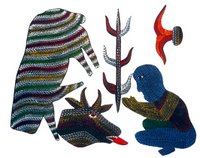
Bhajju Shyam « Gond tribe »
Bhajju Shyam est l'un des jeunes artistes Gond qui ont eu l'occasion de montrer, pour les premières fois, leurs peintures grâce à leur aîné, Jangarh Singh Shyam. (suite)
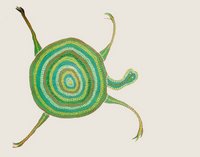
Bhuri Baï « Bill tribe”
Les formes semblables à des esprits convoqués, semblent flotter dans l’espace. Les points colorés qui parsèment ces formes sont autant de points d’ancrages que de dispersions. (suite)
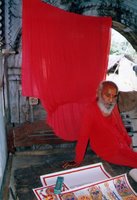
Batohi Jha “Mithila Painting”
Son statut de prêtre tantrique nous rappelle que, selon certains ethnologues ou historiens indiens, le tantrisme aurait pour origine géographique le Bihar. (suite)
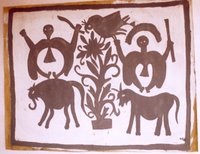
Chano Devi « Godhana painting”
Chano Devi retrouvait enfin cette liberté que j’avais pu entrevoir sur photo d’un autre work shop réalisé au paravent en présence de Sonia Gandhi. (suite)
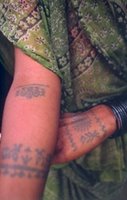
Godhana painting “anonyme”
Chaque dessin s'inspire du monde végétal ou animal et puise l'origine de leurs styles graphiques dans celui, ancestral, du tatouage. (suite)
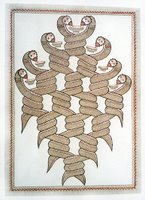
Godawari Dutta “Mithila painting”
La qualité de son trait lui a permis de rapidement s’imposer en Inde mais aussi à l’étranger, comme en témoignent les nombreux grands formats sur papier qu’elle à réalisés au Japon. (suite)
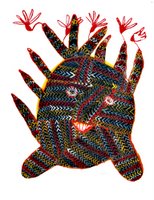
Gond tribe « anonyme I”
Certaines peintures, pour la majorité anonyme comme celles présentées ici, ont cette liberté flamboyante propre à l’enfance. (suite)
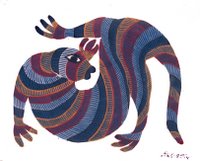
Prasad « Gond tribe”
J'ai rencontré Prasad dans un Institut de recherche sur l'art tribal à Bhopal. Il y travaillait, semble t'il comme homme à tout faire. (suite)

Kumar « Bilboard”
Passionné par les arts populaires, l’un de mes premiers souhaits dès mon arrivée en Inde, en 1996, fut de rencontrer des peintres d’affiches de cinéma. (suite)
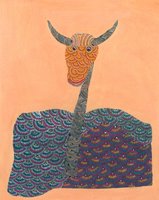
Jangarh Singh Shyam “Gond tribe”
Jangarh Singh Syam a participé à de nombreuses expositions en Inde, dont « Other Master » au Craft Museum de New Delhi, et à l’étranger telle « les magiciens de la terre » en 1989 à Paris. (suite)
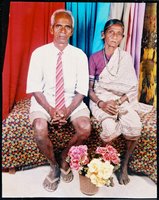
Jivya Soma Mashe “Warli tribe” (english)
I want to draw attention to this artist born in the 1930's in Maharashtra. Although almost unknown by the general public, Jivya Soma Mashe's art is considered by experts as one of the most important Indian tribal art forms of the last sixty years. (more)

Jivya Soma Mashe « Warli tribe (français)
Hervé Perdriolle attire notre regard sur cet artiste, né au début des années 30 dans le Maharashtra. Méconnue du grand public, l'oeuvre picturale de Jivya Soma Mashe est considérée par les experts comme l'une des plus importantes de l'art tribal indien de ces 60 dernières années. (suite)
Ce projet d’exposition et d’édition vient d’un livre ancien trouvé chez un bouquiniste de Calcutta faisant l’éloge du baiser. (suite)
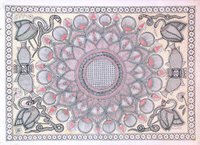
Mahasundari Devi « Mithila painting »
Agée de plus de 70 ans, la vue de Mahasundari Devi est aujourd’hui trop défaillante pour lui permettre de dessiner encore. Elle fût avec Ganga et Sheeta Devi, l’une des toutes premières femmes à contribuer à faire connaître l’art du Mithila hors de ses frontières. (suite)

Moni Mala « Patua”
Moni Mala n’hésite pas à passer des thèmes religieux traditionnels propres aux patuas du West Bengal à des sujets d’inspiration hors du commun où reviennent de manière récurrente des scènes de sexe et de violence. (suite)
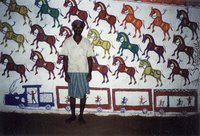
Pithoro painting L’ art rituel des peintres Rathwas du Gujarat est l’un des plus emblématiques de la diversité et de la qualité de l’art tribal indien. (suite)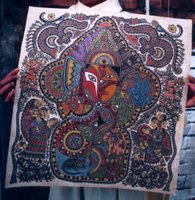 Pushpa Kumari (Mithila Painting)
Pushpa Kumari (Mithila Painting)
Pushpa est la petite fille de Mahasundari Devi, l'une des grandes dames du Mithila painting et nous rappelle, par la même, que l'art pictural dans cet ancien royaume se transmet de mère en fille depuis d'innombrables générations. Pushpa incarne le renouveau de cette tradition artistique. (suite) 
Ram Singh Urveti “Gond Tribe”
Ram Singh Urveti a eu l’occasion de participer à de nombreuses expositions en Inde et à l’étranger. De très belles peintures murales de cet artiste sont conservées au musée de l’homme de Bhopal. (suite)
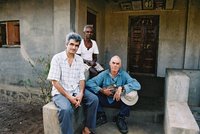
Richard Long / Jivya Soma Mashe (english)
The idea behind this show emerged when I was living in India, in 1996 to 1999, during the many trips I made to discover and study the art of the Warli tribe in the state of Maharashtra, 90 miles north of Mumbai (Bombay). (more)
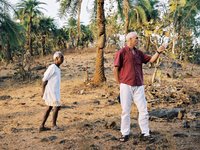
Richard Long / Jivya Soma Mashe (français)
L’idée de cette exposition est née lorsque j’habitais en Inde, de 1996 à 1999, au cours de mes multiples voyages employés à la découverte et à l’étude de l’art de la tribu Warli dans l’Etat du Maharashtra, à 150 km seulement au nord de Mumbay (Bombay). (suite)
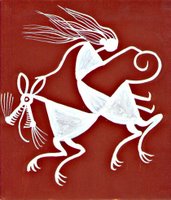
Shantaram Chintya Tumbada “Warli tribe”
Je rencontrais pour la première fois Shantaram Tumbada à l’Alliance Française de Bombay où il m’était présenté par Vishvas Kulkarni, le neveu de Baskar Kulkarni, célèbre peintre et anthropologue indien. (suite)
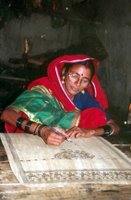
Urmala Devi « Godhana painting »
Urmala devi est né dans les années 50, dans l’état du Bihar, au nord de l’Inde, à 30 km de la frontière avec le Népal. "Intouchable", ses dessins sont d'une rare élégance. (suite)
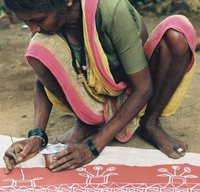
Warli tribe (english)
Based in the Thane District, about 150 km north of Bombay, the Warli tribe numbers over 300,000 members. They have their own beliefs, ritual and customs which have nothing in common with Hinduism. (more)

Warli tribe (français) Située dans le Thane District, à approximativement 150 km au nord de Bombay, la tribu Warli compte encore aujourd'hui plus de 300 000 membres. Les Warli n'ont rien à voir avec l'hindouisme. Ils ont leur propre mode de croyance, de vie et de coutume. (suite)
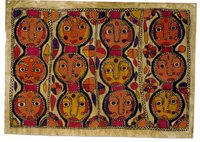
Yamuna Devi « Mithila painting »
Yamuna Devi fût la première "intouchable" à recevoir dans les années 70 un National Awardee, la plus haute des récompenses artistiques du gouvernement indien. (suite)

Yashoda Devi « Mithila painting »
Le nom de Yashoda Devi m’est apparu pour la première fois lors d’une visite au Musée de l’Homme de Bhopal en bas de dessins qui avaient retenu mon attention. Il me fallut plusieurs voyages dans le Mithila avant de pouvoir la rencontrer. (suite)
J’avais le plaisir de partir à la découverte des Kurup dans le Kerala, et d’aller rencontrer Ravinder G. Reddy, dans son atelier de Vishakhapatnam. (suite)
-------------------------------------------------------------------
Most signifiants writing and exhibits organised by Hervé Perdriolle drawing on this collection
Principaux textes écrits et expositions organisées par Hervé Perdriolle autour de la collection
Writings / Textes :
Art tribal et art populaire indiens contemporains, Musée des Arts Décoratifs, Paris 1998.
Tribal Art, Editions Auroville Press International, Auroville, 1999.
Jivya Soma Mashe, the premier artist of the Warli, Tribal Arts, San Franciso, Summer/Autumn 2001.
Dialog : Richard Long, Jivya Soma Mashe, Walther König, Düsseldorf, 2003.
Richard Long, Jivya Soma Mashe, un incontro, Mazzotta, Milano, 2004.
L’art tribal des Adivasi, La revue de l’Inde n°2, Paris 2006.
Peintre, conteur et magicien, La revue de l’Inde n°3, Paris 2006.
Quelle(s) relation(s) voyez-vous aujourd'hui entre nation, identité, cultures d'une part et art contemporain d'autre part ? site web de Ben Vautier, 2004.
Shows / Expositions :
Musée des Arts Décoratifs, Paris, 1998.
Alliances Françaises de Pondichéry et de Bangalore, 1999.
Galerie Dauphin, Singapour, 1999.
Gallery Judy A. Saslow, Chicago, 1999.
Biennale de Lyon, 2000.
Galerie Wam, Caen, 2001.
Centre d’Art Contemporain de Basse-Normandie, 2001.
Museum Kunst Palast, Düsseldorf, 2003.
Padiglione d’Arte Contemporanea, Milano, 2004.
Halle Saint Pierre, Paris, 2007.
Prix AFAA, Ministère des Affaires Etrangères, 1998/1999.
Collections publiques :
Musée de l’Homme, Paris.
Collection de l’Art Brut Lausanne.
Musée du Quai Branly, Paris.
Exhibition, publication, conference, ...,
contact Hervé Perdriolle

















